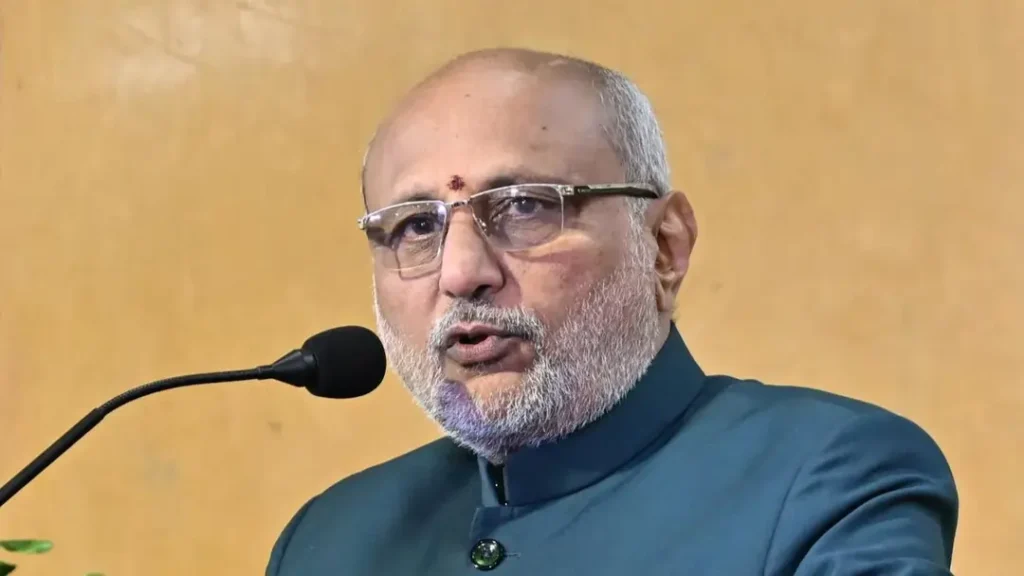New Delhi: In a landmark moment for Indian democracy, C.P. Radhakrishnan, the seasoned Bharatiya Janata Party (BJP) leader and Maharashtra Governor, was elected the 15th Vice-President of India on September 9, 2025, defeating opposition INDIA bloc candidate, former Supreme Court Justice B. Sudershan Reddy, by a margin of 152 votes. The National Democratic Alliance (NDA) nominee secured 452 first-preference votes against Reddy’s 300 in a high-stakes election that saw a 98.20% turnout, with 767 of 781 eligible Members of Parliament (MPs) casting their ballots. The contest, marked by 15 invalid votes and 13 abstentions, unfolded amid the shadow of former Vice-President Jagdeep Dhankhar’s abrupt resignation, sparking debates over parliamentary traditions and political maneuvering.

A Contested Victory: The Electoral Breakdown
The Vice-Presidential election, conducted by Rajya Sabha General Secretary P.C. Mody, drew from an electoral college of 788 MPs across both houses of Parliament, reduced to 781 due to seven vacancies (six in the Rajya Sabha, one in the Lok Sabha). Of the 767 MPs who voted, 752 ballots were valid, setting the winning threshold at 376 votes. Radhakrishnan’s 452 votes, while decisive, fell short of the 500-plus tallies seen in prior elections—Jagdeep Dhankhar’s 528 in 2022 and M. Venkaiah Naidu’s 516 in 2017—reflecting a tighter race than anticipated.
The NDA’s numerical edge, with 425 MPs, was bolstered by the YSR Congress Party’s support, despite abstentions from 14 MPs, including seven from the Biju Janata Dal (BJD), four from the Bharat Rashtra Samithi (BRS), one from the Shiromani Akali Dal, one from the Zoram People’s Movement, one from the Voice of the People Party, and three independents. The opposition, led by the INDIA bloc, rallied behind Reddy, with Congress MP Jairam Ramesh celebrating an “unprecedented 100% turnout” of its 315 MPs, underscoring their unity.
The opposition cast the election as an ideological clash, pitting constitutional values against perceived NDA dominance. However, Radhakrishnan’s victory, announced amid cheers from NDA ranks, reaffirmed their parliamentary clout. Speaking to reporters post-election, Radhakrishnan framed the outcome as a triumph of “nationalistic ideology,” countering the opposition’s narrative of an ideological fight.
The Shadow of Dhankhar’s Departure
The election was necessitated by the sudden resignation of Jagdeep Dhankhar on July 21, 2025, the opening day of the monsoon session. Dhankhar, whose tenure was set to run until 2027, cited health reasons in a cryptic X post, stepping down hours after chairing the Rajya Sabha. His exit, described as “unprecedented” in India’s parliamentary history, fueled speculation of a BJP-orchestrated ouster. Dhankhar has since remained out of the public eye, reportedly staying at Abhay Singh Chautala’s farmhouse, with no official clarity on his whereabouts or the resignation’s triggers.
On September 9, Dhankhar briefly resurfaced with a written statement congratulating Radhakrishnan, calling his elevation a reflection of “trust and confidence by representatives of our nation,” per PTI. However, his silence otherwise has drawn sharp criticism. Samajwadi Party leader Akhilesh Yadav labeled the BJP a “use and throw party,” pointing to Dhankhar’s absence, while Congress President Mallikarjun Kharge called his exit “unexplained and unceremonious,” urging the new Vice-President to uphold parliamentary ethos and resist ruling-party pressures.
Dhankhar’s tenure was contentious, marked by a December 2024 opposition impeachment motion alleging biased conduct as Rajya Sabha Chairman. The motion, dismissed by Deputy Chairman Harivansh for “procedural impropriety,” highlighted the deepening government-opposition rift. Prime Minister Narendra Modi’s response to the resignation—a curt X post on July 22 wishing Dhankhar “good health”—did little to quell the mystery.
Radhakrishnan: A Journey Rooted in Ideology
At 68, Chandrapuram Ponnusamy Radhakrishnan, born October 20, 1957, in Tiruppur, Tamil Nadu, brings a storied career to the Vice-Presidency. A lifelong RSS member since his teens, he joined the Tamil Nadu Bharatiya Jana Sangh executive by 1974, when the Sangh Parivar’s presence in the state was marginal. His ideological steadfastness, rather than political opportunism, defined his rise. Elected to the Lok Sabha from Coimbatore in 1998 and 1999, backed by AIADMK and DMK alliances, he served on key parliamentary committees, including one probing a stock market scam, and represented India at the UN General Assembly.
As Tamil Nadu BJP president from 2004 to 2007, Radhakrishnan led a 93-day “Ratha Yatra,” advocating for river-linking, ending untouchability, countering terrorism, and promoting a Uniform Civil Code. His administrative roles included chairing the Coir Board (2016–2020), where coir exports hit record highs, and serving as BJP’s Kerala in-charge (2020–2022). Appointed Jharkhand Governor in 2023, he took additional charge of Telangana and Puducherry before becoming Maharashtra Governor in July 2024.
A Business Administration graduate, Radhakrishnan is also a sports enthusiast, excelling in table tennis and following cricket and volleyball. His international delegations spanned Asia, Europe, and North America. Modi, in a post-election X post, praised his “devotion to serving society and empowering the poor,” expressing confidence in his ability to “strengthen Constitutional values and enhance Parliamentary discourse.”
Radhakrishnan’s ascent, a year before Tamil Nadu’s assembly elections, signals BJP’s ambition to penetrate the southern state, where it has struggled to gain traction. His role as Rajya Sabha Chairman will test his ability to navigate a polarized Parliament, where executive overreach and the arbitrary classification of bills as “finance bills” have undermined the Upper House’s federal character.
Reddy’s Defiant Stand
Justice B. Sudershan Reddy, the INDIA bloc’s nominee, brought judicial weight to the contest. His campaign, however, faced vitriol, with Union Home Minister Amit Shah accusing him of Naxal sympathies over the 2011 Salwa Judum ruling, which criticized Chhattisgarh’s anti-Maoist vigilante program. On Sunday, Reddy urged MPs to “vote in favour of the country and not any party,” emphasizing national interest.
In defeat, Reddy issued a reflective statement: “This journey has been a profound honour, offering me the opportunity to stand for the values that have guided my life—constitutional morality, justice, and the dignity of every individual. Though the result is not in my favour, the larger cause remains undiminished. The ideological battle continues with ever greater vigour.” His words resonated with the opposition’s call for fairness in parliamentary proceedings.
A New Chapter for the Rajya Sabha
As Vice-President and ex-officio Rajya Sabha Chairman, Radhakrishnan faces a daunting task. The Upper House has seen its influence wane, with parliamentary committees turning into battlegrounds and government-opposition relations growing toxic. His past advocacy for federalism and Centre-state harmony offers hope, but the BJP-RSS inclination toward centralization poses challenges. Observers note his affable demeanor could foster cooperation, potentially easing the combative atmosphere.
Congress leader Kharge emphasized the Vice-Presidency’s role as the “second highest Constitutional office,” urging Radhakrishnan to ensure “independence, fairness, and strength in safeguarding Democratic values.” The election’s context—Dhankhar’s exit, opposition unity, and NDA’s dominance—underscores the need for transparency and accountability.
Radhakrishnan, officially the 17th Vice-President in sequence but the 15th individual to hold the office, met Modi post-victory for congratulations. His remarks to the press framed the win as a validation of national unity, setting the tone for his tenure. As India watches, the “man of faith” steps into a role that demands balancing ideological roots with constitutional impartiality, in a Parliament at a crossroads.
FAQs
1. Who won the 2025 Vice-Presidential election, and what were the vote details?
C.P. Radhakrishnan, the National Democratic Alliance (NDA) nominee, won with 452 first-preference votes against 300 secured by INDIA bloc candidate Justice B. Sudershan Reddy. The election, held on September 9, saw a 98.2% turnout, with 767 of 781 eligible MPs voting. Of these, 752 ballots were valid, and 15 were invalid, setting the winning threshold at 376 votes. Rajya Sabha Secretary-General P.C. Mody announced the results after counting. Despite the NDA’s 425-MP strength, bolstered by YSR Congress Party support, 14 MPs abstained, including seven from Biju Janata Dal, four from Bharat Rashtra Samithi, and one each from Shiromani Akali Dal, Zoram People’s Movement, Voice of the People Party, and three independents. Radhakrishnan’s tally, lower than Jagdeep Dhankhar’s 528 votes in 2022, suggests some cross-voting or strategic abstentions.
2. What triggered the 2025 Vice-Presidential election?
The election was necessitated by Jagdeep Dhankhar’s sudden resignation on July 21, 2025, the first day of Parliament’s monsoon session. Dhankhar, whose term was to end in 2027, cited health reasons in a brief X post after chairing Rajya Sabha proceedings, marking an unprecedented exit. Speculation of internal NDA pressures persists, with opposition leaders like Akhilesh Yadav calling the BJP a “use and throw party.” Dhankhar has since remained out of the public eye, reportedly staying at Abhay Singh Chautala’s farmhouse, though he issued a written statement on September 9 congratulating Radhakrishnan. The Constitution’s Article 68 required filling the vacancy promptly, leading the Election Commission to schedule the poll for September 9, with Deputy Chairman Harivansh managing Rajya Sabha interim duties.
3. Who is C.P. Radhakrishnan, and what is his background?
C.P. Radhakrishnan, born October 20, 1957, in Tiruppur, Tamil Nadu, is a veteran BJP leader and RSS member since his teens. Joining the Bharatiya Jana Sangh in 1974, he served as Tamil Nadu BJP president (2004–2007), leading a 93-day Ratha Yatra to promote river-linking, anti-untouchability, counter-terrorism, and a Uniform Civil Code. Elected to Lok Sabha from Coimbatore in 1998 and 1999, he contributed to parliamentary committees, including one investigating a stock market scam, and represented India at the UN General Assembly. He chaired the Coir Board (2016–2020), driving record exports, and was BJP’s Kerala in-charge (2020–2022). As Jharkhand Governor (2023) and Maharashtra Governor (2024), with additional charge of Telangana and Puducherry, he gained administrative experience. A Business Administration graduate and table tennis enthusiast, Radhakrishnan’s election aligns with BJP’s push into Tamil Nadu ahead of 2026 state elections.
4. How does India’s Vice-Presidential election process work?
The Vice-President is elected by an electoral college of all MPs from Lok Sabha and Rajya Sabha (including nominated members) via secret ballot, using proportional representation with a single transferable vote, as per Article 66. Unlike presidential elections, state legislatures are not involved. Candidates require at least 20 proposers and seconders, must be Indian citizens aged 35 or older, and eligible for Rajya Sabha. Voting occurred in Parliament House from 10 a.m. to 5 p.m. on September 9, with no party whips to ensure secrecy. The electoral college comprised 788 MPs, reduced to 781 due to seven vacancies (six in Rajya Sabha, one in Lok Sabha). Counting followed immediately, with results notified in the Gazette. Radhakrishnan’s oath, to be administered by President Droupadi Murmu, is scheduled for September 12 at Rashtrapati Bhavan.
5. What are the political and parliamentary implications of this election?
Radhakrishnan’s win solidifies NDA’s dominance but highlights opposition unity, with Congress claiming 100% turnout of its 315 MPs, though Reddy’s 300 votes suggest potential cross-voting. The opposition framed the contest as an ideological battle for constitutional values, while Radhakrishnan called it a “nationalistic” victory. As Rajya Sabha Chairman, he inherits a polarized House where “money bill” classifications bypass Upper House scrutiny, eroding its federal role. His federalism advocacy and affable demeanor could bridge divides, but BJP’s centralizing tendencies challenge his impartiality. Congress leader Mallikarjun Kharge urged him to uphold democratic fairness, while Reddy vowed to continue the “ideological battle.” With Tamil Nadu elections looming, Radhakrishnan’s role—officially the 17th Vice-Presidential term but 15th individual holder—could shape BJP’s southern strategy and parliamentary dynamics.

